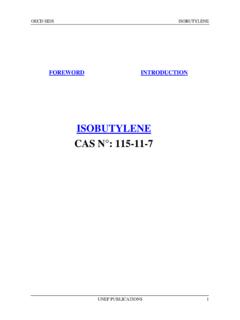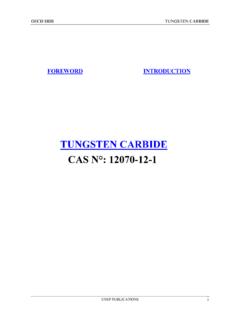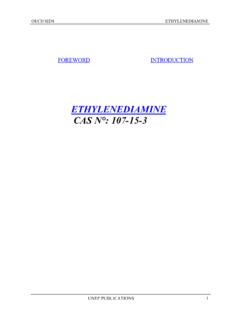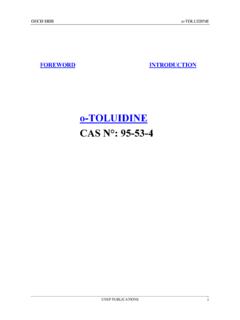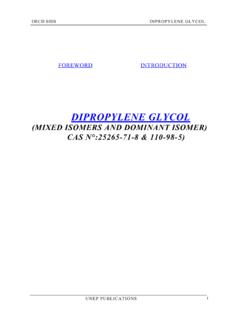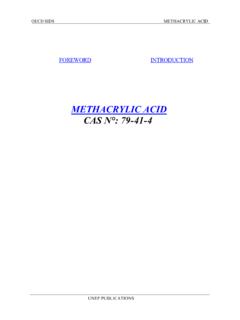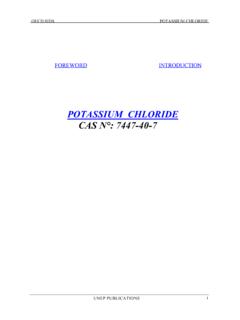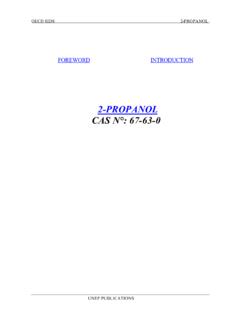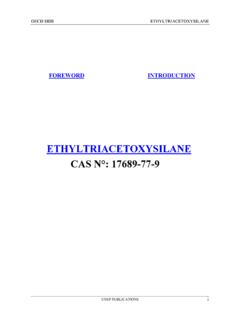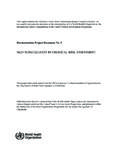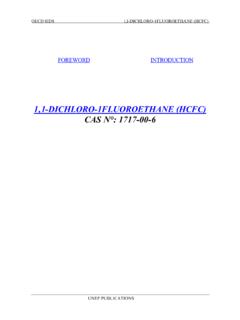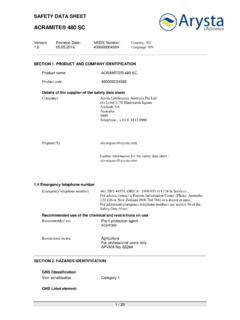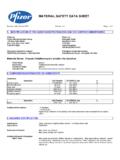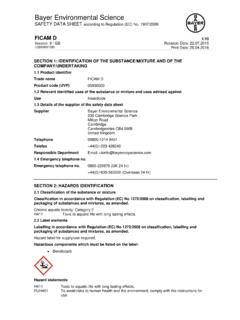Transcription of Bis(2-ethylhexyl)adipate (DEHA) CAS N°: 103-23-1
1 OECD SIDS Bis(2-ethylhexyl)adipate UNEP PUBLICATIONS 1 FOREWORD INTRODUCITON Bis(2-ethylhexyl)adipate (DEHA) CAS N : 103-23-1 OECD SIDS Bis(2-ethylhexyl)adipate UNEP PUBLICATIONS 2 SIDS Initial Assessment Report For SIAM 10 Tokyo, Japan, 15-17 March 2000 1. Chemical Name: Bis(2-ethylhexyl)adipate (DEHA) 2. CAS Number: 103-23-1 3. Sponsor Country: United States National SIDS Contact Point in Sponsor Country: Oscar Hernandez, Division Director RAD 7403 M 1200 Pennsylvania Avenue Washington DC, 20460 4. Shared Partnership with: 5. Roles/Responsibilities of the Partners: Name of industry sponsor /consortium Process used 6. Sponsorship History SIDS Dossier and Testing Plan were reviewed by the US EPA and the following SIDS Testing Plan was recommended: no testing (X) testing ( ) This SIAR was reviewed at SIAM 8 (Paris, October, 1998) at which the human health assessment and conclusions were accepted and the environmental assessment was to be revised and discussed at a subsequent SIAM.
2 How was the chemical or category brought into the OECD HPV Chemicals Programme ? 7. Review Process Prior to the SIAM: 8. Quality check process: 9. Date of Submission: 10. Date of last Update: 11. Comments: OECD SIDS Bis(2-ethylhexyl)adipate UNEP PUBLICATIONS 3 SIDS INITIAL ASSESSMENT PROFILE CAS No. 103-23-1 Chemical Name Bis(2-ethylhexyl)adipate Structural Formula OOOO RECOMMENDATIONS The chemical is a candidate for further work. SUMMARY CONCLUSIONS OF THE SIAR Human Health DEHA exhibits low acute mammalian toxicity as seen by reported oral and dermal LD50s in rats of greater than 2 g/kg and no mortality in rodents exposed via inhalation for eight hours at levels up to saturation. Available data show that DEHA is not irritating to skin or eyes in animal studies and was not a dermal sensitizer in guinea pigs.
3 Repeated-dose toxicity studies (up to 90-days) in rats and mice with DEHA in feed showed reduced body weight gains at levels of approximately 400 mg/kg and higher in rats and approximately 600 mg/kg and higher in mice (NOAELs of 189 mg/kg in rats and 451 mg/kg in mice). In vitro genotoxicity studies have been negative for mutations, unscheduled DNA synthesis and DNA interactions in bacterial and mammalian systems. In vivo genotoxicity studies have also been negative (two mouse micronucleus assays). DEHA has been evaluated for carcinogenicity in mice and rats, and there was no evidence of carcinogenicity in rats but there was evidence of liver cancer in female mice (significant incidence) and male mice (less significant).
4 Tumors in mice were observed at high concentrations (3222 mg/kg for females and 2659 mg/kg in males). A one-generation reproductive toxicity test was performed in rats and there were no effects on reproduction although the body weight gains of pregnant dams and first generation pups was reduced at a dose level of approximately 3222 mg/kg. A developmental toxicity performed with DEHA in rats (animals treated orally via DEHA in feed on days 6-15 of gestation) demonstrated reduced maternal body weight gain at the highest dose (1080 mg/kg/d). There was evidence of pre-implantation fetal loss at the highest dose, but no gross, skeletal, or visceral abnormalities. A NOAEL for developmental toxicity was determined in rats at an estimated oral dose of 170 mg/kg/d, based on slight fetotoxicity from reduced ossification which was not statistically significant.
5 Environment Experiments show that DEHA has no acute toxicity effects to aquatic organisms and a low bioaccumulation potential, and is readily degradable via abiotic (hydrolysis) and biotic processes. No acute aquatic toxic effects were noted at the apparent limit of DEHA solubility ( mg/L) and no effects were noted at concentrations several orders of magnitude greater than the solubility for most species. A chronic daphnid study did show effects at OECD SIDS Bis(2-ethylhexyl)adipate UNEP PUBLICATIONS 4 concentrations slightly above the water solubility limit. There were no effects observed at the lowest concentration tested ( mg/L). An acceptable toxic concentration of mg/L was derived as the geometric mean of the NOEC ( mg/L) and the LOEC ( mg/L).
6 A PNEC of mg/L has been established ( divided by an assessment factor of 10). Tests on terrestrial organisms (earthworm) have also been performed (LC50s of >1000 mg/kg and 865 mg/kg were reported after exposures of 7 and 14 days, respectively. Exposure DEHA is a plasticizer used primarily in food-contact wrapping. Approximately 10,000 to 50,000 tonnes are produced each year in closed systems. It is estimated that only 25-50 individuals in the US are involved in the manufacturing and handling process. Occupational exposures are low based on production in a closed system and its low vapor pressure. The estimated exposure levels to the general population via consumer products (migration of DEHA from food wraps estimated exposures of 117 ug/kg/d) and the environment (highest measured surface water concentration was mg/L) are considered to be quite low in several countries.)
7 NATURE OF FURTHER WORK RECOMMENDED Because of the potential chronic hazard to the aquatic environment an exposure assessment is recommended with subsequent risk assessment, as appropriate. OECD SIDS Bis(2-ethylhexyl)adipate UNEP PUBLICATIONS 5 SIDS Initial Assessment Report 1 IDENTITY Identification of the Substance CAS Number: 103-23-1 IUPAC Name: Bis(2-ethylhexyl)adipate Molecular Formula: C22H42O4 Structural Formula: Molecular Weight: Synonyms: DEHA Purity/Impurities/Additives DEHA is a clear liquid at room temperature which is manufactured as >99% pure. A minor impurity is adipic acid. Physico-Chemical properties The physical properties of DEHA are shown in Table 1. DEHA is a colorless (Ashford, 1994) to light colored (Verschueren, 1983) liquid.
8 DEHA is a liquid over a wide range of temperatures ranging from C (melting point) to 417 C (boiling point). The density of DEHA is g/mL, which is slightly less than water. This means that it will generally float on top of water, but also easily forms emulsions with water when a slight amount of energy is applied. The aqueous solubility of DEHA has been reported in three studies, one of which yielded greatly different results from the other two. The first test utilized a separator column technique that yielded a solubility of < mg/L (Monsanto, 1982). The second test utilized a vigorous shake flask technique that stirred a mixture of water and DEHA (Monsanto, 1983) and resulted in aqueous solubilities of mg/L and mg/L in freshwater and saltwater, respectively.
9 It is believed that these elevated values represent the presence of emulsions formed by the vigorous stirring. A third test has been performed that measured the aqueous solubility of DEHA using the slow stir method and reported a measured aqueous solubility of mg/L (Parkerton, TF et al., in review, J. Chem. Eng. Data). OECD SIDS Bis(2-ethylhexyl)adipate UNEP PUBLICATIONS 6 The log of the octanol-water partition coefficient (log Kow) for DEHA was calculated from its structure. Log Kow values of > to have been determined (Felder et al., 1986; US EPA, 1984; SRC, 1998). These values suggest that DEHA is a hydrophobic compound expected to have low solubility in water and a tendency to move out of water to other matrices. The low water solubility (likely low ppb range) and high log Kow (greater than ) values for DEHA can be supported by looking at analogous chemicals such as dibutyl adipate, dihexyl adipate, and diisononyl adipate.
10 These chemicals have estimated or measured water solubilities of 16 mg/L (IUCLID, 1998a), 42 ug/L (Howard and Meylan, 1997), and < 1 mg/L (IUCLID, 1998b) and estimated log Kows of , , and (USEPA,1994), respectively. Table 1 Summary of physico-chemical properties Property Test Description Results Comments Reference Melting Point Boiling Point C +417 C Density (g/mL) Aqueous Solubility ( g/L) Saturator column technique Slow stir technique < Values of 230 to 780 g/L were also reported using vigorous stir-flask method, which likely creates emulsions. Slow-stir techniques eliminate the formation of emulsions Monsanto, 1982, 1983; Parkerton, 1999 Vapor Pressure (Pa) @ 20o C calculated from vapor pressure measured at 200 C Felder, 1986 2 GENERAL INFORMATION ON EXPOSURE Di-(2-ethylhexyl) adipate (DEHA) is often referred to by the archaic name di-octyl adipate (DOA) in technical literature.
